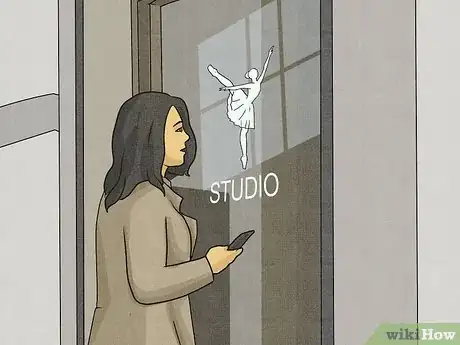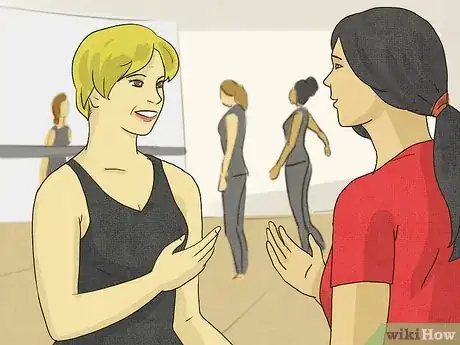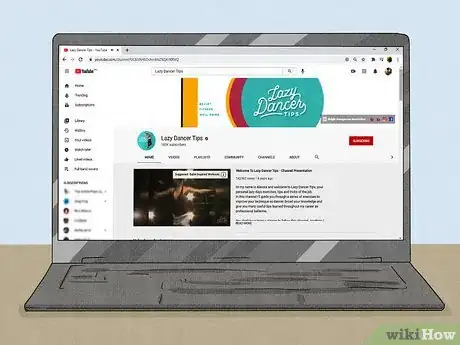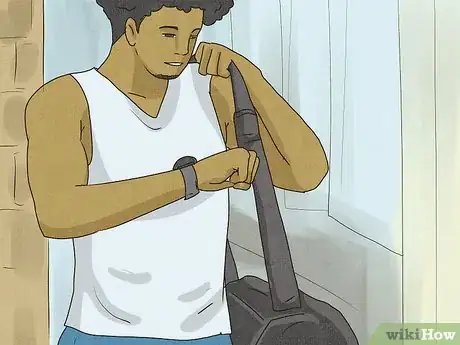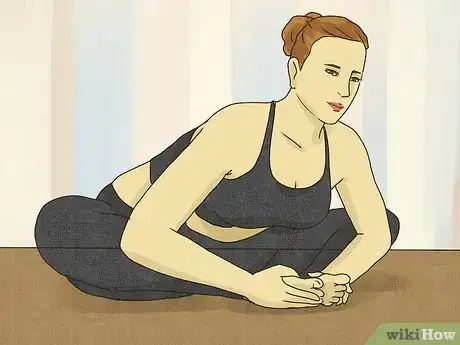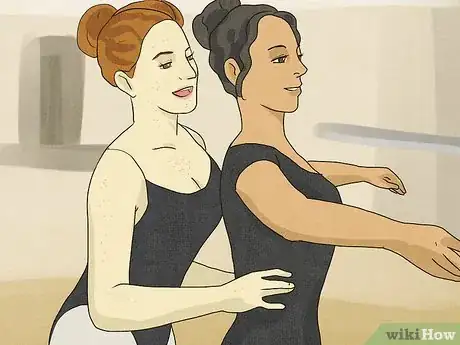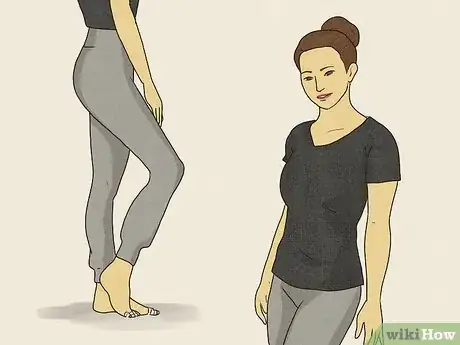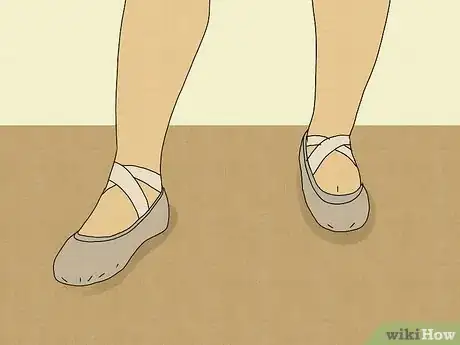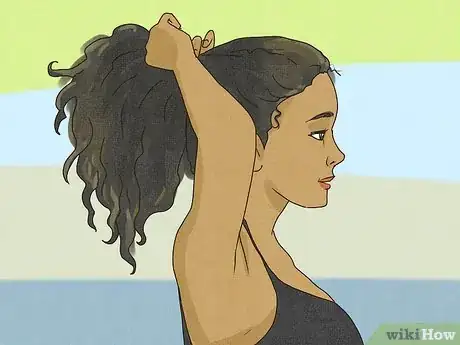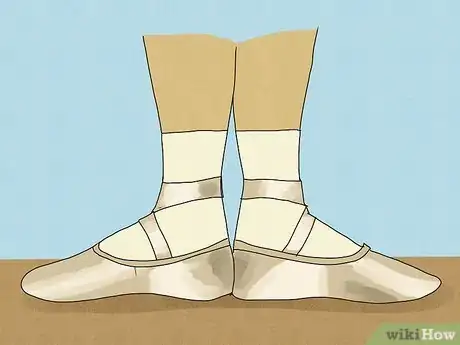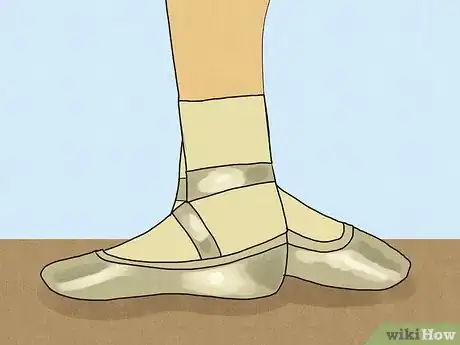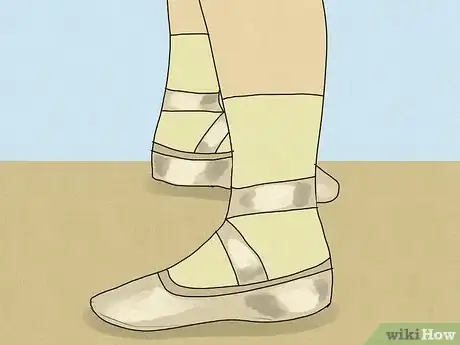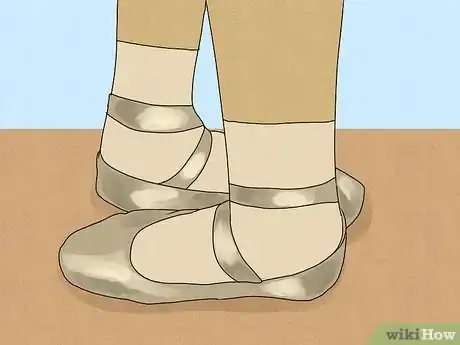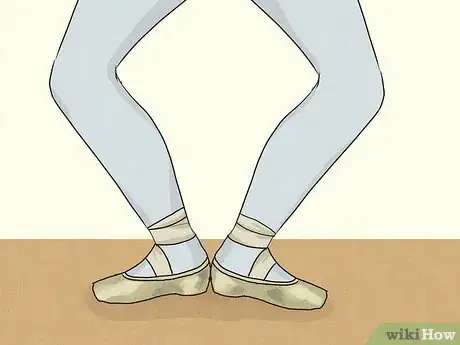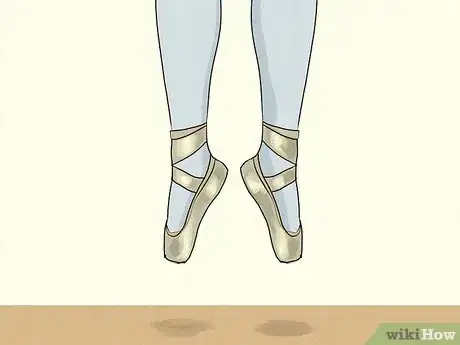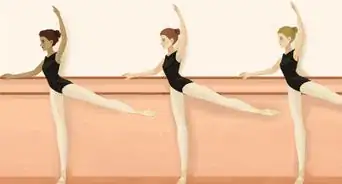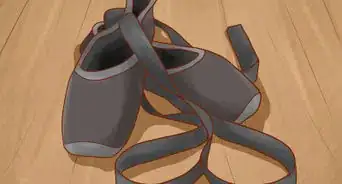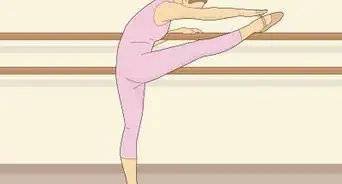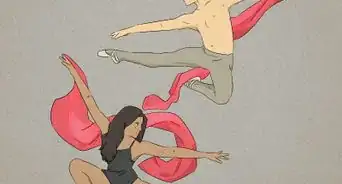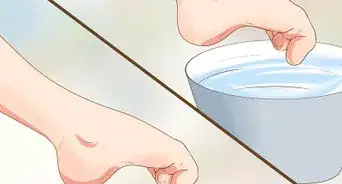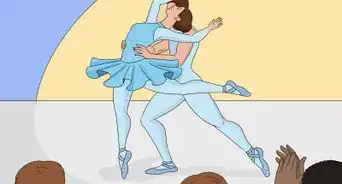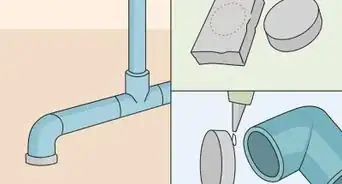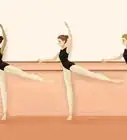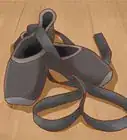This article was co-authored by Geraldine Grace Johns and by wikiHow staff writer, Janice Tieperman. Geraldine Grace Johns is a Professional Ballerina and the Owner of Grace Ballet in New York and Los Angeles. Geraldine toured through New Zealand, Australia, Japan, and Korea as Jammes in Ken Hill's Original Phantom of the Opera. She has studied with the Royal Academy of Dance in London to become a teacher and taught for the Kudo School of Ballet in Yokohama. Geraldine also ran her own Royal Academy of Dance School in New Zealand before studying at the Neighborhood Playhouse School of the Theatre in New York City. Geraldine was a guest coach and Master Class teacher in Toronto for the Canadian Royal Academy of Dance's Dance Challenge in 2018, 2019, and 2020. She was also a guest coach and Master Class teacher for the USA Royal Academy of Dance Challenge in Long Beach, California in 2019 and 2020. Grace Ballet Los Angeles has won recognition as one of 13 Best Ballet Schools in Los Angeles since opening her school. Geraldine is a contract Practical Teaching Supervisor for the Certificate in Ballet Teaching Studies for the Royal Academy of Dance.
There are 14 references cited in this article, which can be found at the bottom of the page.
wikiHow marks an article as reader-approved once it receives enough positive feedback. In this case, 100% of readers who voted found the article helpful, earning it our reader-approved status.
This article has been viewed 193,073 times.
If you’ve always wanted to learn ballet but never had a chance to take classes, don’t give up on your ballet dreams just yet! This elegant activity isn’t just meant for young kids; in fact, it’s a great workout for people of all ages. It’s okay if you don’t have much experience—it’s easy to familiarize yourself with the world of ballet, even if you’re an adult.
Steps
Classes and Practice
-
1Search for a studio that hosts adult classes.[1] Check online to see what types of ballet studios are in your area. See what types of classes they offer—some studios offer adult beginner classes, which are a great starting point.[2]
- If there’s a ballet studio in your town or community, feel free to stop by and check it out.
- You might feel more comfortable visiting the studio first before officially signing up for classes.
-
2Sign up for classes with a supportive instructor. A good ballet teacher won’t pick favorites, gloss over ballet techniques, or be critical of your performance. If you don’t feel comfortable or supported in your class, search for a new studio and instructor that feel like a better fit.[3]
- A good instructor will give you personalized, specific feedback on your technique.
Advertisement -
3Practice at home with YouTube tutorials. Check out channels like Lazy Dancer Tips, Kathryn Morgan, Claudia Dean World, and Sarah Arnold for helpful, easy-to-follow tutorials. Some channels also offer extra paid content, if you’d really like to take your at-home training to the next level.[4]
- Online tutorials are a great resource, but in-person lessons are the best way to master your technique safely and correctly.
- When you're practicing at home, use an open area where you can move around comfortably without bumping into any furniture. Use a sofa, table, or ledge as a makeshift “barre” to help you practice and master different ballet moves on your own time. Also, practice in front of a mirror so you can double-check your form.[5]
-
4Arrive early for your first class. It’s okay if you feel out of your element at first! Get to your class several minutes early, so you can get the lay of the land before the session starts. Try to claim a spot toward the center of the barre, so you can watch and mimic the more advanced students.[6]
- Typically, advanced students hang out toward the ends of the barre.
-
5Warm up before starting your ballet lesson.[7] Lift your heels up and down for a couple minutes—this “prancing” motion helps warm up your whole body. Then, get your blood pumping with 30-second reps of jumping jacks. Splits and butterfly stretches are also great ways to warm yourself up before diving into your ballet class.[8]
- With a butterfly stretch, hold the bottoms of your feet together in front of you, creating “butterfly” wings with your knees and legs. Pull your heels inward to give yourself a great stretch.
-
6Take private lessons to help you focus on your personal goals. Group classes can be helpful, but they can also feel a bit confusing and overwhelming. That’s okay! If you’re interested in taking your ballet journey another step further, sign up for private lessons where you can get individualized instruction. In private lessons, prioritize what you’re struggling with, and work with your teacher to reach your ballet goals.[9]
Dress Code
-
1Slip into comfortable, form-fitting clothes.[10] You don’t have to wear a leotard or tutu when you learn ballet. Instead, pick out a comfortable tee or tank top, along with a pair of form-fitting pants. This way, your ballet instructor can keep a close eye on your form throughout the lesson.
- Some ballet studios might have a specific dress code. Before heading into class, double-check the studio’s website and see what requirements they have (if any).
-
2Slide into some flat ballet shoes. Traditional ballet shoes aren’t pointe shoes—they’re flat, comfortable, and great for ballet dancers of all levels.[11] You can find these shoes in different colors, and they’re typically made with canvas or leather.[12]
- To be safe, double-check your studio’s website to see what kind of shoes they prefer.
- You can find ballet shoes at specialty dancewear stores, or you can shop for them online. Sites like DiscountDance and Dance Supplies are great places to start![13]
-
3Tie or pin your hair up before class. Pull your hair back into a ponytail, or twist it into a simple bun. If your hair is shorter or layered, keep it secure with bobby pins and/or a hair band.
Ballet Terminology
-
1Turn your feet outward in first position. Keep your heels touching, with your feet forming a wide “V” shape. For your own safety, don’t twist your knees—instead, use your hips to turn your feet outward. [14]
- As you’re starting out, it’s completely fine and understandable if you can’t turn your feet that far. You’ll get better as you continue practicing ballet!
-
2Space your feet apart to perform second position. Recreate first position, turning both feet outward in a “V” shape. Then, spread both feet apart, leaving about 1½ foot lengths between them. As you reach second position, balance and center your weight along both feet.[15]
-
3Cross your feet partially to reach third position. Step forward with your right foot, turning your foot outward as you go.[16] Then, turn your left foot outward. Cross your right heel in front of your left, with your right heel touching your left toe.[17]
- Third position isn’t used very often, since it looks a lot like fifth position.[18]
-
4Separate your feet to create fourth position. Start in third position, with your right heel touching your left toe. Then, step forward with your right foot, keeping both feet turned outward.[19] In this position, space out both feet by about one foot length.[20]
- It’s called “closed fourth position” when your feet are in line with one another. If you separate both your feet further to the left and right, it’s called “open fourth position.”
-
5Pull your feet together in fifth position. Starting from fourth position, pull your right foot directly in front of your left foot. In fifth position, your feet will be completely crossed, with the outer edge of your right foot touching the inner edge of your left foot.[21]
- It’s okay if you have trouble crossing your feet at first! As you practice, this position will get easier.
-
6Bend your knees to do a plie. Position your feet in first position, keeping them both flat on the floor. Then, bend your knees so they stick out over your toes.[22]
- Plie is pronounced as “plee-ay.”
-
7Jump in the air to do a saute. Lower yourself into a plie, and then launch yourself into the air. Straighten out your legs while you’re in midair, and then land back in a plie position.[23]
- This move is pronounced as “soh-yay.”
Expert Q&A
Did you know you can get expert answers for this article?
Unlock expert answers by supporting wikiHow
-
QuestionCan you go on pointe with no experience?
 Geraldine Grace JohnsGeraldine Grace Johns is a Professional Ballerina and the Owner of Grace Ballet in New York and Los Angeles. Geraldine toured through New Zealand, Australia, Japan, and Korea as Jammes in Ken Hill's Original Phantom of the Opera. She has studied with the Royal Academy of Dance in London to become a teacher and taught for the Kudo School of Ballet in Yokohama. Geraldine also ran her own Royal Academy of Dance School in New Zealand before studying at the Neighborhood Playhouse School of the Theatre in New York City. Geraldine was a guest coach and Master Class teacher in Toronto for the Canadian Royal Academy of Dance's Dance Challenge in 2018, 2019, and 2020. She was also a guest coach and Master Class teacher for the USA Royal Academy of Dance Challenge in Long Beach, California in 2019 and 2020. Grace Ballet Los Angeles has won recognition as one of 13 Best Ballet Schools in Los Angeles since opening her school. Geraldine is a contract Practical Teaching Supervisor for the Certificate in Ballet Teaching Studies for the Royal Academy of Dance.
Geraldine Grace JohnsGeraldine Grace Johns is a Professional Ballerina and the Owner of Grace Ballet in New York and Los Angeles. Geraldine toured through New Zealand, Australia, Japan, and Korea as Jammes in Ken Hill's Original Phantom of the Opera. She has studied with the Royal Academy of Dance in London to become a teacher and taught for the Kudo School of Ballet in Yokohama. Geraldine also ran her own Royal Academy of Dance School in New Zealand before studying at the Neighborhood Playhouse School of the Theatre in New York City. Geraldine was a guest coach and Master Class teacher in Toronto for the Canadian Royal Academy of Dance's Dance Challenge in 2018, 2019, and 2020. She was also a guest coach and Master Class teacher for the USA Royal Academy of Dance Challenge in Long Beach, California in 2019 and 2020. Grace Ballet Los Angeles has won recognition as one of 13 Best Ballet Schools in Los Angeles since opening her school. Geraldine is a contract Practical Teaching Supervisor for the Certificate in Ballet Teaching Studies for the Royal Academy of Dance.
Professional Ballerina & Ballet Instructor Going on pointe requires many, many years of training and strengthening your footwork, calves, and feet. There are many factors that determine when you can go on pointe, including your age, the size of your feet and toes, and your level of strength. It's really your teacher's decision as to when you're ready to go on pointe.
Going on pointe requires many, many years of training and strengthening your footwork, calves, and feet. There are many factors that determine when you can go on pointe, including your age, the size of your feet and toes, and your level of strength. It's really your teacher's decision as to when you're ready to go on pointe. -
QuestionI am 13 years. Should I go to the adult class or children's class?
 Lhowl8Community AnswerMost dance schools have a variety of classes for ages from about four or five to adult, as well as adult beginner classes. There will probably be a class of people your age, but if you are just starting, it may be better for you to join a slightly younger class to gain a good technique foundation. Also, a lot of adult classes focus on fitness and fun more than technique -- often they do not offer exams.
Lhowl8Community AnswerMost dance schools have a variety of classes for ages from about four or five to adult, as well as adult beginner classes. There will probably be a class of people your age, but if you are just starting, it may be better for you to join a slightly younger class to gain a good technique foundation. Also, a lot of adult classes focus on fitness and fun more than technique -- often they do not offer exams. -
QuestionWhat if I'm 38 years old?
 Community AnswerIt is never to late to follow your dreams, but you need to work really hard.
Community AnswerIt is never to late to follow your dreams, but you need to work really hard.
References
- ↑ Geraldine Grace Johns. Professional Ballerina & Ballet Instructor. Expert Interview. 11 November 2020.
- ↑ https://www.seattletimes.com/life/wellness/5-pro-tips-for-your-first-absolutely-beginning-adult-ballet-class/
- ↑ https://www.seattletimes.com/life/wellness/5-pro-tips-for-your-first-absolutely-beginning-adult-ballet-class/
- ↑ https://bestpointe.com/en/blog/1279-online-ballet-resources/
- ↑ https://www.findyourcenteronline.com/blog/best-beginning-ballet-barres
- ↑ https://www.seattletimes.com/life/wellness/5-pro-tips-for-your-first-absolutely-beginning-adult-ballet-class/
- ↑ Geraldine Grace Johns. Professional Ballerina & Ballet Instructor. Expert Interview. 11 November 2020.
- ↑ https://www.masterclass.com/articles/how-to-warm-up-for-ballet#quiz-0
- ↑ https://hkdancemagazine.com/stories/2019/3/4/private-vs-group-dance-lessons
- ↑ Geraldine Grace Johns. Professional Ballerina & Ballet Instructor. Expert Interview. 11 November 2020.
- ↑ Geraldine Grace Johns. Professional Ballerina & Ballet Instructor. Expert Interview. 11 November 2020.
- ↑ https://www.seattletimes.com/life/wellness/5-pro-tips-for-your-first-absolutely-beginning-adult-ballet-class/
- ↑ https://www.businessinsider.com/best-ballet-shoes
- ↑ https://www.adult-ballet.org/basic-ballet-positions/
- ↑ https://www.adult-ballet.org/basic-ballet-positions/
- ↑ https://m.youtube.com/watch?v=J--Z-bq4YZs&t=1m37s
- ↑ https://m.youtube.com/watch?v=J--Z-bq4YZs&t=1m42s
- ↑ https://www.pbt.org/learn-and-engage/resources-audience-members/ballet-101/basic-ballet-positions/
- ↑ https://m.youtube.com/watch?v=J--Z-bq4YZs&t=2m15s
- ↑ https://www.adult-ballet.org/basic-ballet-positions/
- ↑ https://www.adult-ballet.org/basic-ballet-positions/
- ↑ https://www.pbt.org/learn-and-engage/resources-audience-members/ballet-101/basic-ballet-positions/
- ↑ http://saconnects.org/wp-content/uploads/Ultimate-Ballet-Vocab-1.pdf
- ↑ https://www.thefashionspot.com/wellness/562943-starting-ballet-as-an-adult/
